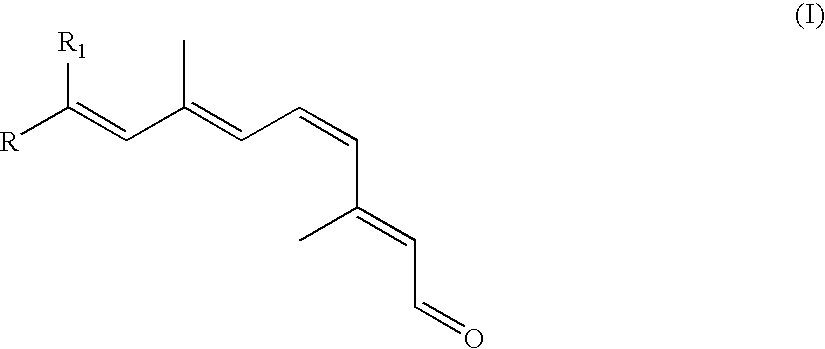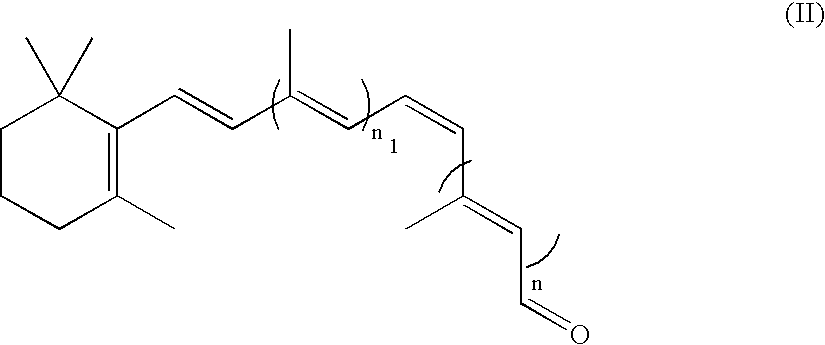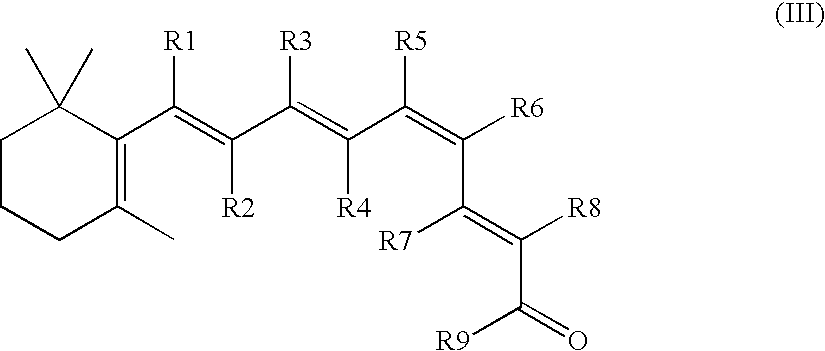Retinoid replacements and opsin agonists and methods for the use thereof
- Summary
- Abstract
- Description
- Claims
- Application Information
AI Technical Summary
Benefits of technology
Problems solved by technology
Method used
Image
Examples
example 1
[0083] The visual process is initiated by the photoisomerization of 11-cis-retinal to all-trans-retinal. For sustained vision, the 11-cis-chromophore must be regenerated from all-trans-retinal. This requires RPE65, a dominant retinal pigment epithelium protein. Disruption of the RPE65 gene results in massive accumulation of all-trans-retinyl esters in the retinal pigment epithelium, lack of 11-cis-retinal and therefore rhodopsin, and ultimately blindness. It was previously reported that in Rpe65− / − mice, oral administration of 9-cis-retinal generated isorhodopsin (a rod photopigment) and restored light sensitivity to the electroretinogram (Van Hooser et al., Proc. Natl. Acad. Sci. USA 97:8623-28 (2000)). In this study, early intervention by 9-cis-retinal administration significantly attenuated retinal ester accumulation and supported rod retinal function for more than 6 months post-treatment. In single cell recordings, rod light sensitivity was shown to be a function of the amount o...
example 2
[0136] Phototransduction is initiated by the photoisomerization of rhodopsin (Rh) chromophore 11-cis-retinylidene to all-trans-retinylidene. Here, using rhodopsin regenerated with retinal analogs with different ring sizes, which prevent isomerization around the C11═C12 double bond, the activation mechanism of this G-protein-coupled receptor was investigated. 11-cis-7-ring-rhodopsin does not activate G-protein in vivo and in vitro, and it does not isomerize along other double bonds, suggesting that it fits tightly into the binding site of opsin. In contrast, bleaching 11-cis-6-ring-rhodopsin modestly activates phototransduction in vivo and at low pH in vitro. These results reveal that partial activation is caused by isomerization along other double bonds in more rigid 6-locked retinal isomers and protonation of key residues by lowering pH in 11-cis-6-ring-rhodopsins. Full activation is not achieved, because isomerization does not induce a complete set of conformational rearrangements...
PUM
| Property | Measurement | Unit |
|---|---|---|
| Composition | aaaaa | aaaaa |
| Sensitivity | aaaaa | aaaaa |
Abstract
Description
Claims
Application Information
 Login to View More
Login to View More - R&D
- Intellectual Property
- Life Sciences
- Materials
- Tech Scout
- Unparalleled Data Quality
- Higher Quality Content
- 60% Fewer Hallucinations
Browse by: Latest US Patents, China's latest patents, Technical Efficacy Thesaurus, Application Domain, Technology Topic, Popular Technical Reports.
© 2025 PatSnap. All rights reserved.Legal|Privacy policy|Modern Slavery Act Transparency Statement|Sitemap|About US| Contact US: help@patsnap.com



